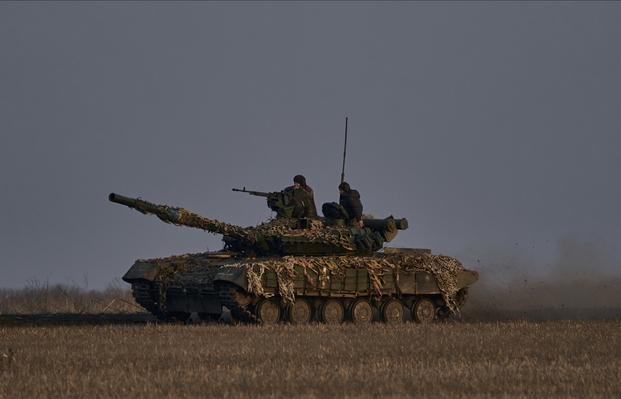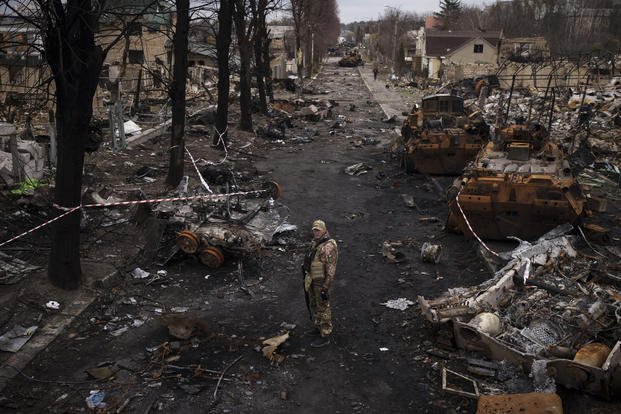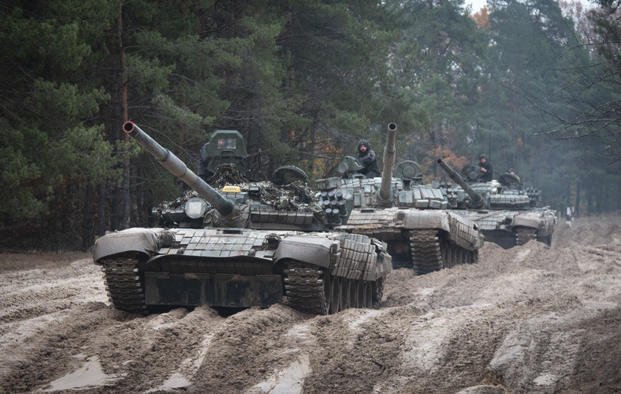Read the original article on Business Insider.
With several models of tanks to choose from, a large supply of armored vehicles, and an undeniable numbers advantage, Russia's fleet of tanks should ostensibly be decimating Ukraine's on the battlefield.
Instead, the struggling superpower has racked up error after error more than a year into the war, resulting in staggering equipment and battle losses as Ukraine attempts to even the playing field ahead of an influx of Western tanks expected to arrive in the coming months.
While the current state of the conflict — a brutal stalemate in Bakhmut — has not been defined by tank warfare, earlier in the war tank battles captured international attention, including when Ukraine used abandoned Russian tanks to shore up its counteroffensive in Kharkiv last year, and during Russia's failed siege of Vuhledar earlier this year, which was the site of the largest tank battle yet.
The armored vehicles' great strength on the battlefield is three-fold, according to Mark Cancian, a retired US Marine Corps colonel and a senior advisor with the Center for Strategic International Studies security program. Tanks provide mobility, firepower, and protection, Cancian told Insider, offering soldiers the luxury of moving and shooting at the same time.
But when it comes to tanks, practicality is only part of the equation. One of their key capabilities, according to Jeffrey Edmonds, a Russia expert at the Center for Naval Analyses and former US Army armor officer, is the psychological impact they have on the enemy, known as the "shock effect."
Symbolic or not, tank warfare remains a vital aspect of the ongoing war for both sides with Russia reportedly returning to storage to restock its depleted supply and Ukraine continuing its crusade for further aid.

Russia has more tanks, more advanced tanks, and more types of tanks than Ukraine
Throughout the war, Russia has primarily relied on four different models of tanks: T-64s, T-72s, T-80s, and T-90s, with T-72s making up the bulk of their fleet thanks to years of Soviet-era production and more modern updates to the vehicles.
While each tank type has its own distinct style, Cancian and Edmonds told Insider that the vehicles are part of a similar lineage, with each generation of tank representing an updated version of the last.
As a general rule of thumb, "the newer the tank, the more capable it is," Cancian said of Russia's fleet.
But there are exceptions to the rule, the military experts said. The Russians relied on the T-72 so heavily during the Cold War that countless updates and refurbishments rendered the model's capabilities comparable or even superior to that of its direct successor, the T-80, which is generally considered less successful and reliable than the T-72 or the T-90, the latter of which is thought to be Russia's most advanced tank, Edmonds and Cancian said.
Russia's tank design is the product of lessons learned in World War II, according to Edmonds, and as a result, the vehicles tend to be smaller and lighter than Western tanks, as well as lower to the ground, which makes them harder to hit, but also less powerful in a matchup against a heavily-armored, NATO-sized vehicle.
Not accounting for wartime losses, Russia is believed to have started the conflict with an army fleet of about 3,000 tanks, according to several reports citing the International Institute for Strategic Studies — nearly double the number of Ukraine's estimated 1,500-strong pre-war fleet.
Even with thousands of tanks on the battlefield, however, diversity among the vehicles has been slim, with Ukraine relying exclusively on its collection of T-64s and T-72s, the same types of tanks that Russia is using.
Enemies forced to face one another using near identical tanks is a result of the countries' shared Soviet history. When the war started, both sides were armed primarily with the same Soviet equipment. But even with the overlap, Cancian and Edmonds said the Russian versions of these tanks, in particular the T-72s, are likely more advanced than their Ukrainian counterparts, given years of updates that Ukraine never had reason to make.
On paper, Russia undoubtedly has the better specs. But the battlefield tells another story.
"The lethality of the system depends on much more than the system itself," Edmonds said of tanks. "It depends on the crew, but it also depends on how it fits into the battlefield and how it integrates with other components of combat power."

Russia hasn't been using its tanks effectively
Not only has the Russian military been struggling to properly utilize its tanks, but it has also had one hell of a time trying to maintain them.
Stunning February updates from the International Institute for Strategic Studies and Oryx, an open-source intelligence analysis platform, estimated that Russia has lost about half of its operational tank fleet — more than 1,500 tanks — since the war began. The staggering losses reportedly hit Russia's store of T-72s and T-80s especially hard, with IISS suggesting the country's supply has been depleted by two-thirds, according to reports.
"The conventional wisdom is that the Russians aren't following their own doctrine," Cancian said. "They have not been using their tanks as part of a combined team."
A key part of effective tank warfare is using the vehicles in tandem with infantry, air support, artillery, and engineers — a tactic known as combined arms, according to Cancian and Edmonds.
In one of the earliest displays of dysfunction, the Russians sent a convoy of unprotected tanks straight into an ambush in Bucha just weeks into the war. Then, earlier this year, the Russians repeated the very same mistake in Vuhledar, leading to the loss of more than 100 tanks, several of which were seen smoking and blazing in the Ukrainian snow.
Had the Russians practiced combined arms, they might have sent an infantry team ahead of the tanks to clear the terrain for incoming vehicles and scout possible attack points. But that type of cohesion takes training, and lots of it, Cancian and Edmonds said, a particular struggle among the Russians, who receive most of their training on the job.
"They clearly came into this with a lower level of tactical training than we thought," Edmonds said of the Russian military.
Cohesion among Russian soldiers is unlikely to improve as Russia sustains more than 220,000 casualties, a top UK defense official said this week, citing US intelligence. That number represents a stunning figure that has undoubtedly exacerbated already-existent personnel problems within the military.
Not only do the Russians have too few people to provide proper infantry support, the army seems to be running out of people to operate the remaining tanks. In Vuhledar earlier this year, Ukrainian troops said they captured a Russian medic who was forced to drive a tank, despite his medical background.
Russia's repeated mistakes have been costly, forcing the country to rely on older tanks they've since pulled from storage, including T-62s, T-55s, and T-54s, some of which date as far back as the 1940s.
These decade-old replacements are slower and lack the fire control of modern tanks, Edmonds said; they are generally less effective than their updated counterparts, though still have the capacity to be lethal.
Ukraine, meanwhile, has contributed to Russia's depleted supply, having captured several advanced T-72s ,T-80s, and even some T-90s from the enemy, though the country has also lost between 450-700 tanks itself, according to reports citing the IISS. The Ukrainian military seems to be better at operating their tanks on a tactical level, Edmonds said, citing the army's greater flexibility and initiative.
Ukraine is set to receive an influx of Western tanks soon
Following months of pleading from President Volodymyr Zelenskyy, Ukraine finally secured the promise of a long-desired tank haul from several Western countries earlier this year.
The US has pledged to send Ukraine 31 M1A1 Abrams tanks in the coming months; the UK is preparing 14 Challenger 2 tanks to send; Germany promised 14 Leopard 2 tanks; and several other European countries have also pledged to send tanks from their fleet of German-made Leopard 2s.
It's a hefty haul of Western tanks which boast better armor and fire control than the Russian T-72s, Cancian said. All three Western tank models are larger than most Russian tanks and are "quite survivable" thanks to their advanced armor, according to Edmonds.
"Those three tanks are all essentially equivalent," Cancian said, though he gave the slight edge to the American-made Abrams tanks, which have been upgraded more often than the Leopards and Challengers.
It's still unclear when the Western tanks will arrive or what role they will ultimately play in Ukraine's future offensives. Tank usage in the conflict has been minimal in recent weeks as the battle of Bakhmut — an ongoing slog of attrition — rages on.
"This stalemated frontline where we are right now, this is not a good environment for tanks," Cancian said. "Tanks need to break into the open."
The incoming vehicles could help shake up the current state of the war, according to Edmonds.
"Tanks were designed precisely for that," he told Insider. "To be brought in to make something static…very fluid."
The much anticipated Ukrainian spring or summer offensive will likely be an attempt to break into the open and upset the Russians' lines, Edmonds said, a goal that would be aided by a fleet of tanks.
But the number of incoming Western tanks — less than 150 — is unlikely to change the tides of war. Cancian predicted that the tanks will be enough for the Ukrainians to execute "one good" attack as part of their counteroffensive.
"You just have a numbers problem. Even if they're really good, which they are, the numbers are just too small to fundamentally change tank warfare," he said.
The Russians, despite their flailing tank usage thus far, are believed to have thousands of old tanks still in storage to which they can return even, and especially, if they continue to sustain significant equipment losses.
"The Russians, like the Soviets, never threw anything away," Cancian said.
But the promise of incoming Western tanks sets the stage for possible additional equipment assistance to Ukraine in the future, Edmonds said.
"The longer this war goes on, the more effective this type of support will be," he said.












